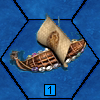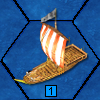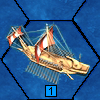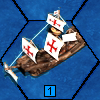The ships (Construction, equipment and properties)
General information about ships (Land & Lords version 4.0, only on Server 1)
Ships are used to explore the map and to transport armies and spies to other islands, or attack other ships. Like land unit are organized in armies, ships are organized in fleets. Fleets can be moved on the map similar to armies or spies, by right clicking on them on the map or by entering individual moves in the fields view. Addionally, a target field can be entered fot fleets. However, the target field has to be visible to you. Once you researched "map making", also fields in the "fog of war" can by selected as target fields. Only sea fields or harbor fields (your own or your allies) can be selected. This can be used to facilitate shipment of reinforcements or to summon your fleets on a selected field. However, you cannot use it to automatically explore unknown fields on the map. All fleets have a viewing range of 3 fields. The maximum speed of a fleet on the map is 6 fields per tick and is limited by the slowest ship of the fleet.
Building fleets
Fleets are built in habors. Each harbor can only build one fleet at a time. How long the building of a fleet take, depends on the type and number of the ships. Harbors with a high level can build ships much faster. With increasing harbor level, also the quality (=XP) of the crew increases, an important factor for their success in battles. At the beginning of the game, only knarrs can be built. By researching the seafaring path, larger ship types become available. By building a shipyard (harbor slot extension), the building time and cost of ships can be further reduces.
Each type of ship has a different cargo capacity, which is needed to transport troops or spies. How many cargo space a unit uses occupies can be found under [Loading and unloading of ships]. When building a fleet you should also take note that only knarrs and drakkars can drop armies on the coast line.
In the building menue you can see, how many resource the fleet will need (1), the speed of the fleet (2), the crew number (3), the cargo space (4), and the landing capacity (=how many units per turn can be landed on a coast) (5) of the fleet.
When you are content with the composition of your fleet and if you have the needed resources to build it, you only have to add a name for the fleet and click on the button "build fleet".
You can cancel the building of a fleet anytime. 90% of the used resources will be refunded.
Damage and repairs
- Fleets can be damage by naval battles or when the fleet limit has been exceeded. Accordingly the readiness of your fleet drops. Fleets with a readiness <100% have reduced cargo capacity and only the respecive part of their crew will be available during battle. The readiness of a fleet cannot drop below 10%.
- The readiness of damaged fleets will be automatically increased again, when they are anchored in a harbor. Duration and cost of the repairs are proportional to the normal building cost. The level of the harbor, your research and the availability of a shipyard (harbor slot extension) will be taken into account.
Ship types
Numbers in brackets are valid since version 4.2
* When castelles have been researched
- Crew: Similar to armies, the crew for a fleet is recruited from the harbour field and the surrounding fields.
- Cargo size: Determines, how many armies and spies can be transported
- Battle speed: Decisive for the ramming phase of a sea battle. Slower ships are easier sunk by enemy dromones.
- Travel speed: Number of fields a ship type can move on the map per tick. The slowest ship of a fleet determines its speed.
- Boarding factor: Important factor during the boarding phase of a sea combat. The combat value of the attached armies is multiplied with this factor.
- Landing boat: This ship type can place units directly onto coast fields (forest, plains). The cargo size of the langing boats of a fleet reflects the maximum number of units, that can be unloaded per tick. If the cargo size is not large enough to unload an army in one tick, the placing of the army might take multiple ticks.
- Ramming skid: Dromones have an underwater ramming skid. Thuis skid can sink enemy shiüs during the ramming phase in a ship battle.
- Catapult: Holk, dromones und galeys have a ship catapult. This ship catapult provides supporting fire for the seamna of the fleet.
- minimal harbour size: Dromone, galeys and carracks can only land on harbours sizes 6 and up.
Viking knarr
Basic ship type that is already available at the start of the game. Forests and plains can be reached by armies with a knarr.
Viking drakkar
Very fast battle and landing boat. Forests and plains can be reached by armies with a drakkar.
Hanseatic koggen
A slow cargo ship. It has the best cost/(cargo size × speed)-ratio of all ships.
English holk
A very slow cargo ship. It has the best cost/cargo size - ratio of all ships.
Byzantinian dromone
A battle ship with large crew and medium travel speed. It can ram other ships with its underearter ramming skid and sink them.
Venetian galley
A large battle ship with very large crew.
Portuguese caravelle
A very fast cargo ship with low capacity.
Genoan caracke
A very large cargo ship of medium speed. It has a very good boarding factor.








